Book contents
- Frontmatter
- Dedication
- Contents
- List of Figures
- Preface
- Introduction
- 1 “Founded upon the Rock Which is Christ”: What Patrick and His Promoters Reveal about Women in the Early Irish Church
- 2 “A New and Apostolic Band of Virgins Arose”: Darerca, an Exceptionally Learned Abbess
- 3 “The Safest City of Refuge”: Brigid the Bishop
- 4 “God is Always Present with Those who Exemplify Such Devotion”: Íte, Foster-Mother of the Saints of Ireland
- 5 “Do not Harass my Sisters”: Samthann, an Abbess not to be Crossed
- 6 “I Place Myself under the Protection of the Virgins all Together”: Sister Saints with Something Like a Life
- Conclusion
- Appendices
- Appendix A The Sites
- Appendix B The Sources
- Appendix C Feast Days of Early Medieval Irish Female Saints
- Appendix D Glossary
- Appendix E Pronunciation of Personal Names
- Bibliography
- Index
1 - “Founded upon the Rock Which is Christ”: What Patrick and His Promoters Reveal about Women in the Early Irish Church
Published online by Cambridge University Press: 24 November 2020
- Frontmatter
- Dedication
- Contents
- List of Figures
- Preface
- Introduction
- 1 “Founded upon the Rock Which is Christ”: What Patrick and His Promoters Reveal about Women in the Early Irish Church
- 2 “A New and Apostolic Band of Virgins Arose”: Darerca, an Exceptionally Learned Abbess
- 3 “The Safest City of Refuge”: Brigid the Bishop
- 4 “God is Always Present with Those who Exemplify Such Devotion”: Íte, Foster-Mother of the Saints of Ireland
- 5 “Do not Harass my Sisters”: Samthann, an Abbess not to be Crossed
- 6 “I Place Myself under the Protection of the Virgins all Together”: Sister Saints with Something Like a Life
- Conclusion
- Appendices
- Appendix A The Sites
- Appendix B The Sources
- Appendix C Feast Days of Early Medieval Irish Female Saints
- Appendix D Glossary
- Appendix E Pronunciation of Personal Names
- Bibliography
- Index
Summary
Abstract
While little can be said with certainty about Irish Christianity's first few centuries, Patrick's concern and respect for women provide powerful testimony about gender relations and female agency in the fifth century. He acknowledged male ecclesiastical hierarchy outside of Ireland, but in country his primary partners in the faith were female. His seventh-century and subsequent biographers proclaim his dominance over virtually everything and everyone in Ireland, but they allow us to hear echoes of women’s voices and spheres of activity. Patrician texts, which serve primarily male interests, attest to the wide range of possibilities for women in the Irish church and proclaim women's rights over both their property and themselves, as they also show how those rights were negotiated within the early Irish church.
Key words: earliest Irish Christianity, slavery, syneisaktism, married religious
Pardon the irony—beginning a book about reclaiming women's history with a chapter focusing on a man. But Patrick isn't just any man; he's regarded as Ireland's primary patron saint, though he has two partners in that role, Brigid and ColmCille. He was placed in that position due to a fluke of history: his writings, describing his work spreading the faith in Ireland, survived where others perished, a lasting beacon like Inis Cathaig to Canair after all other lights had dimmed. He left us two texts, his Confession (Confessio), or autobiography about his spiritual journey and missionary work, and Letter to the soldiers of Coroticus (Epistola), written to a Christian chieftain and his men after they abducted recent converts to sell as slaves. Somehow Patrick’s writings came into Armagh's possession; its propagandists claimed him as its founder, recasting him into a near godlike mold, and Patrick, and Ireland, were never the same again.
Chances are, you should try to forget what you know about Patrick before proceeding. The amateur hour of drunken debauchery unleashed upon the masses on his feast day, Shamrock Shakes, the dyeing of the Chicago River—none of that has anything to do with Patrick himself. Even aspects with greater claim on the Patrician legend—the banishing of snakes, the conversion of the entire island to Christianity, the truly impressive vindictive cursing—are remote from the man revealed in his own words.
- Type
- Chapter
- Information
- Sacred SistersGender, Sanctity, and Power in Medieval Ireland, pp. 41 - 60Publisher: Amsterdam University PressPrint publication year: 2019



